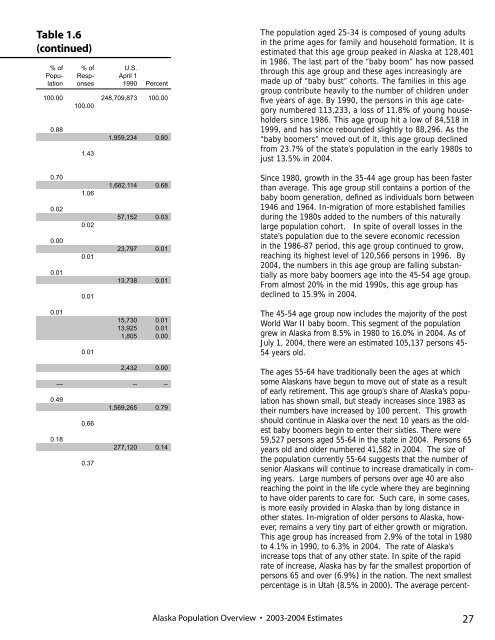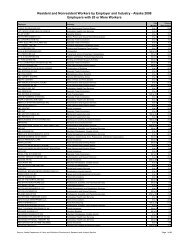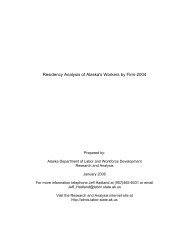Untitled - Research and Analysis Home - State of Alaska
Untitled - Research and Analysis Home - State of Alaska
Untitled - Research and Analysis Home - State of Alaska
Create successful ePaper yourself
Turn your PDF publications into a flip-book with our unique Google optimized e-Paper software.
Table 1.6<br />
(continued)<br />
% <strong>of</strong><br />
Population<br />
% <strong>of</strong><br />
Responses<br />
U.S.<br />
April 1<br />
1990 Percent<br />
100.00 248,709,873 100.00<br />
100.00<br />
0.88<br />
1.43<br />
1,959,234 0.80<br />
The population aged 25-34 is composed <strong>of</strong> young adults<br />
in the prime ages for family <strong>and</strong> household formation. It is<br />
estimated that this age group peaked in <strong>Alaska</strong> at 128,401<br />
in 1986. The last part <strong>of</strong> the “baby boom” has now passed<br />
through this age group <strong>and</strong> these ages increasingly are<br />
made up <strong>of</strong> “baby bust” cohorts. The families in this age<br />
group contribute heavily to the number <strong>of</strong> children under<br />
five years <strong>of</strong> age. By 1990, the persons in this age category<br />
numbered 113,233, a loss <strong>of</strong> 11.8% <strong>of</strong> young householders<br />
since 1986. This age group hit a low <strong>of</strong> 84,518 in<br />
1999, <strong>and</strong> has since rebounded slightly to 88,296. As the<br />
“baby boomers” moved out <strong>of</strong> it, this age group declined<br />
from 23.7% <strong>of</strong> the state’s population in the early 1980s to<br />
just 13.5% in 2004.<br />
0.70<br />
0.02<br />
0.00<br />
0.01<br />
1.06<br />
0.02<br />
0.01<br />
0.01<br />
1,682,114 0.68<br />
57,152 0.03<br />
23,797 0.01<br />
13,738 0.01<br />
Since 1980, growth in the 35-44 age group has been faster<br />
than average. This age group still contains a portion <strong>of</strong> the<br />
baby boom generation, defined as individuals born between<br />
1946 <strong>and</strong> 1964. In-migration <strong>of</strong> more established families<br />
during the 1980s added to the numbers <strong>of</strong> this naturally<br />
large population cohort. In spite <strong>of</strong> overall losses in the<br />
state’s population due to the severe economic recession<br />
in the 1986-87 period, this age group continued to grow,<br />
reaching its highest level <strong>of</strong> 120,566 persons in 1996. By<br />
2004, the numbers in this age group are falling substantially<br />
as more baby boomers age into the 45-54 age group.<br />
From almost 20% in the mid 1990s, this age group has<br />
declined to 15.9% in 2004.<br />
0.01<br />
0.01<br />
15,730 0.01<br />
13,925 0.01<br />
1,805 0.00<br />
The 45-54 age group now includes the majority <strong>of</strong> the post<br />
World War II baby boom. This segment <strong>of</strong> the population<br />
grew in <strong>Alaska</strong> from 8.5% in 1980 to 16.0% in 2004. As <strong>of</strong><br />
July 1, 2004, there were an estimated 105,137 persons 45-<br />
54 years old.<br />
2,432 0.00<br />
--- -- --<br />
0.49<br />
1,569,265 0.79<br />
0.66<br />
0.18<br />
277,120 0.14<br />
0.37<br />
The ages 55-64 have traditionally been the ages at which<br />
some <strong>Alaska</strong>ns have begun to move out <strong>of</strong> state as a result<br />
<strong>of</strong> early retirement. This age group’s share <strong>of</strong> <strong>Alaska</strong>’s population<br />
has shown small, but steady increases since 1983 as<br />
their numbers have increased by 100 percent. This growth<br />
should continue in <strong>Alaska</strong> over the next 10 years as the oldest<br />
baby boomers begin to enter their sixties. There were<br />
59,527 persons aged 55-64 in the state in 2004. Persons 65<br />
years old <strong>and</strong> older numbered 41,582 in 2004. The size <strong>of</strong><br />
the population currently 55-64 suggests that the number <strong>of</strong><br />
senior <strong>Alaska</strong>ns will continue to increase dramatically in coming<br />
years. Large numbers <strong>of</strong> persons over age 40 are also<br />
reaching the point in the life cycle where they are beginning<br />
to have older parents to care for. Such care, in some cases,<br />
is more easily provided in <strong>Alaska</strong> than by long distance in<br />
other states. In-migration <strong>of</strong> older persons to <strong>Alaska</strong>, however,<br />
remains a very tiny part <strong>of</strong> either growth or migration.<br />
This age group has increased from 2.9% <strong>of</strong> the total in 1980<br />
to 4.1% in 1990, to 6.3% in 2004. The rate <strong>of</strong> <strong>Alaska</strong>’s<br />
increase tops that <strong>of</strong> any other state. In spite <strong>of</strong> the rapid<br />
rate <strong>of</strong> increase, <strong>Alaska</strong> has by far the smallest proportion <strong>of</strong><br />
persons 65 <strong>and</strong> over (6.9%) in the nation. The next smallest<br />
percentage is in Utah (8.5% in 2000). The average percent-<br />
<strong>Alaska</strong> Population Overview • 2003-2004 Estimates 27








